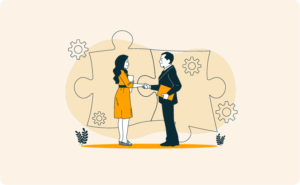In B2B customer support, the integration of systems like Salesforce with support software is not just a convenience—it’s a game-changer. Supportbench’s commitment to this integration exemplifies a forward-thinking approach that resonates deeply within the enterprise space. This article delves into the multifaceted benefits and applications of Salesforce synchronization, underscoring its pivotal role in streamlining workflows and bolstering agent efficiency. It’s also equally crucial to understand the dire consequences for companies that overlook the necessity of seamless Salesforce synchronization in their support platforms.

The 5 benefits of a Salesforce Synchronization
1. Real-Time Data Accessibility and Improved Decision Making
Real-time access to customer data is crucial for support agents. A study by Salesforce found that 89% of business customers expect companies to understand their needs and expectations. Salesforce synchronization ensures that agents have immediate access to customer information, enabling them to make informed decisions quickly.
2. Enhanced Personalization in Customer Interactions
Now more than ever, personalization is key to customer satisfaction. According to Epsilon, 80% of consumers are more likely to make a purchase when brands offer personalized experiences. Salesforce integration allows agents to see a customer’s history, preferences, and past interactions, enabling a more tailored approach. You can use customer history data to tailor conversations and solutions and offer proactive support.
3. Streamlined Workflow and Increased Productivity
Efficiency is crucial in support operations. As per a report by McKinsey, well-implemented tech can improve productivity by up to 25%. Salesforce integration streamlines workflows, reducing the time spent on manual data entry and allowing more time for meaningful customer interactions. You can automate routine tasks and data entry and in turn optimize your support processes and workflows.
4. Accurate Reporting and Analytics for Strategic Decision Making
We know that accurate data is essential for strategic planning. A survey by KPMG showed that 95% of CEOs rely on data and analytics for strategic decision-making. Integrating Salesforce ensures that the data used in reports is current and accurate, leading to more informed decisions. You can use these integrated analytics for real-time reporting and far more accurate and seamless decision making.
5. Improved Collaboration Among Teams
Collaboration is vital for enterprise success, particularly in the competitive B2B space. Salesforce synchronization allows for seamless sharing of customer data across departments, leading to better collaboration. A study by McKinsey found that companies promoting collaborative working were 5 times more likely to be high-performing. It is essential to implement collaborative tools that integrate with Salesforce. But not taking all of this into account can have detrimental consequences.
5 Consequences of not having Seamless Salesforce Synchronization
Inefficient Data Management:
Without integration, companies face the risk of operating with outdated or siloed customer information, leading to inefficiencies and errors in customer interactions. Salesforce reports that 91% of CRM data is incomplete, and 70% goes bad annually. This situation is exacerbated when systems are not synchronized, leading to potentially costly missteps in customer service.
Decreased Agent Productivity:
Agents without access to integrated systems spend more time toggling between applications to gather customer information, significantly reducing their efficiency. According to a Pega survey, employees switch between 35 job-critical applications more than 1,100 times every day, drastically lowering productivity.
Impaired Customer Experience:
A lack of seamless integration can lead to inconsistent customer experiences. As found by Salesforce, 75% of customers expect consistent experiences across multiple channels, which is hard to achieve without integrated systems.
Challenges in Personalization:
Without integrated customer insights, personalization efforts can fall flat. Given that 72% of customers only engage with personalized messaging (SmarterHQ), this can be a significant setback in customer engagement strategies.
Strategic Misalignment:
Decision-making can be severely hampered due to the lack of real-time, integrated data insights. Gartner highlights that poor data quality is responsible for an average of $15 million per year in losses.
Revolutionizing Customer Support with Supportbench
Supportbench is not just keeping pace with these trends; it’s setting them. By integrating Salesforce, Supportbench offers a revolutionary approach to customer support. This integration is significant as it aligns with the broader objectives of efficiency, personalization, and data-driven decision-making in enterprise environments. And that is because Supportbench has a seamless integration with Salesforce. And of course Supportbench’s ease of use and scalability ensure that support teams can adapt and grow without constant IT intervention, fostering a culture of independence and innovation. But let’s delve a little deeper:
The 5 benefits of a Salesforce-Supportbench Integration
Real-Time Data Accessibility and Improved Decision Making:
By providing real-time access to customer data, Supportbench ensures informed and quick decision-making, essential for effective customer support.
Enhanced Personalization in Customer Interactions:
Leveraging Salesforce data, Supportbench allows for a more personalized approach in customer interactions, crucial for enhancing customer satisfaction and loyalty.
Streamlined Workflow and Increased Productivity:
The integration leads to more efficient workflows, allowing agents to spend more time on meaningful customer interactions and less on manual data entry.
Accurate Reporting and Analytics for Strategic Decision Making:
Integrated analytics provide real-time, accurate data for informed strategic decisions, crucial for the long-term success of the enterprise.
Improved Collaboration Among Teams:
Seamless integration fosters better collaboration between departments, enhancing overall operational efficiency and customer service quality.
Conclusion
The integration of Salesforce with Supportbench is not just an operational choice—it’s a strategic necessity in today’s customer-centric environment. By focusing on real-time data access, personalized customer interactions, streamlined workflows, accurate analytics, and improved collaboration, Supportbench is equipping enterprises to not only meet but exceed their customer support goals. This is not just about keeping up with the times; it’s about setting a new standard for what effective, efficient, and empathetic customer support should look like in the enterprise world. This synergy goes beyond mere convenience, fundamentally enhancing how customer support is delivered and experienced. By avoiding the pitfalls of disconnected systems, enterprises can leverage the full potential of their customer support operations, ensuring not only improved efficiency and productivity but also fostering deeper customer relationships and driving sustainable business growth.











